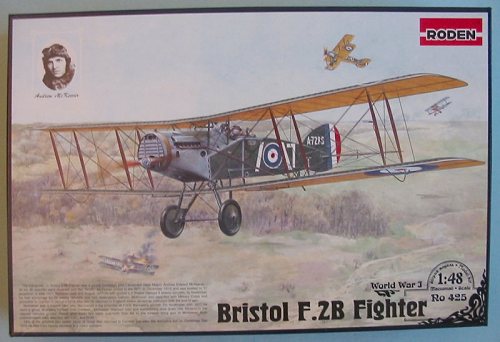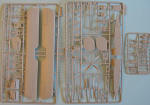
| KIT: | Roden 1/48 F.2B "Brisfit" |
| KIT #: | 426 |
| PRICE: | $19.96 MSRP ($17.96 at Squadron) |
| DECALS: | Six options |
| REVIEWER: | Tom Cleaver |
| NOTES: |

| HISTORY |
The Bristol Fighter is easily one of the most outstanding aircraft to see action during the First World War. It was so good that it formed the backbone of the RAF in overseas service policing the far-flung frontier territories of the Empire throughout the interwar period until it was finally retired from service in 1934.
Originally ordered as a replacement for the wretched B.E.2 series, the Bristol Fighter was originally seen as just another 2-seat Corps Reconnaissance aircraft, and when it was handled the way one handled a B.E.2 or R.E.8, losses were severe. Fortunately, it was soon discovered that this was not just another 2-seater, but was instead a 2-seat fighter, that was fully capable of mixing it with German single-seaters successfully. Canadian Andrew McKeever became the top ace flying the Bristol Fighter, with 30 victories scored between June and November 1917, with his gunner L.F. Powell also becoming an ace. In fact, there are over 30 “gunner aces” in the RAF’s lists for the First World War, and all but five of them were gunners in Bristol Fighters. Keith Park - who would go on to fame as AOC 11 Group during the Battle of Britain and later at Malta during the Second World War, became the top New Zealand ace of the First World War in the Bristol Fighter, with a score of 22. The aircraft served on all fronts in which the RFC and RAF were deployed, with equal success.
| THE KIT |
 This
is the fourth Bristol Fighter to be produced in 1/48 injection-molded
plastic and the first one since the very early Aurora kit of the 1950s to
be a mainstream injection-molded kit.
This
is the fourth Bristol Fighter to be produced in 1/48 injection-molded
plastic and the first one since the very early Aurora kit of the 1950s to
be a mainstream injection-molded kit.
While the Aeroclub and
Blue Max limited-run kits are make up into nice models of the Bristol
Fighter with “some modeling skill required,” this kit from Roden beats them
50 ways from Sunday on price and kit quality. There is no fear of the
“dread wing ripple,” no wh ite
metal parts to be deformed inside the box on their way to your model
bench. Surface detail is petite and looks very accurate. While the kit is
no Tamigawa toss-it-together project, it is certainly the equal of anything
released by Eduard in recent years.
ite
metal parts to be deformed inside the box on their way to your model
bench. Surface detail is petite and looks very accurate. While the kit is
no Tamigawa toss-it-together project, it is certainly the equal of anything
released by Eduard in recent years.
While you have the choice of an airplane painted in P.C.10 and Clear Doped Linen or an airplane painted in P.C.10 and Clear Doped Linen, the decal sheet provides markings for McKeever’s Brisfit, another from 48 Squadron circa 1918, one from 139 Squadron on the Italian Front in 1918, a Home Defense airplane also from 1918 and two from 1 Squadron, Australian Flying Corps in Palestine, both with white fuselages.
| CONCLUSIONS |
The Bristol Fighter has always been one of my favorite World War I airplanes, and I have been eagerly awaiting the arrival of this kit. From what’s in the box, I don’t think I’ve been disappointed.
Thanks to Roden for the review kit.
You can find this kit and many others at

If you would like your product reviewed fairly and quickly by a site that has over 250,000 visitors a month, please contact me or see other details in the Note to Contributors.